📊 You are data-driven you say? So, what ifyour data sucks?
A killer for business. But what if you want to lose weight and know if your strategy is working (or not), this can be bloody annoying (or even unhealthy), as well.
🤨 THE PROBLEM
Even when you have proper weighing scales like the hashtag#InBody that I am reviewing, there are still challenges that don’t seem to be solved.

TIMING
In general your weight fluctuates throughout the day, but also throughout the week. Moreover it’s dependent on many factors, like your level of hydration, the contents of your stomach and your intestines, but even how long it has been since your last workout.
TECH
Then there are weighing scales that have poor tech to distinguish between the chicken filet in your leg muscles and the one in your stomach. And there are others that rely on assumptions for your upper body, while measuring only the lower side of your body correctly. Not so awesome when most of your (overweight) seems to reside in the top part of your body.
🤔 AWESOME SOUNDING, BUT BAD SOLUTION
Sure, you can go to a location where you put yourself in a tank of water every week or have yourself get scanned with (low level) radiation to check your body properly.
However, as a wise American poet once said:
‘Ain’t nobody got time for that’
🤓 LESS CATCHY, BUT BETTER SOLUTION
I believe there’s a few things to do here:
✅ Get a weighing scale that uses at least 2 frequencies
✅ Optimize the influenceable part of your measurements
✅ Weigh yourself at the same time each day
✅ Only measure once or twice a week
With this in place, you still need to realize that:
✅ Poor + consistent > Perfect + inconsistent
✅ Done > Perfect
✅ Trend lines > data points
🙋♂️ Curious to hear if you have any smart ways to clean up the dirt from your data to discover its hidden beauty (and not throw out the baby with the bathwater)
Check out the original post on LinkedIn and consider following me to get more updates like this.



